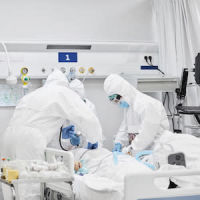A major challenge in ICUs even before the COVID-19 pandemic was ventilator-associated pneumonia (VAP). However, now that the ICUs are even more overwhelmed with the complex and prolonged acute care of patients with COVID-19, VAP has become an even bigger issue. It has an overall incidence of 40 to 60%, but the problem is that the variation on VAP definitions used in different countries makes it very difficult to compare the incidence rates.
In a study conducted by Vacheron et al. (2021), researchers evaluated a cohort of COVID-19 patients and compared them with another cohort of patients without COVID-19. The two cohorts were matched by age, sex, hospital centre, presence of antibiotics, time from ICU admission to mechanical ventilation and Simplified Acute Physiology Score II at admission. Findings from the study show a 66% increase in the incidence of VAP in patients with COVID-19. Incidence was 15.4 per 1000 ventilation days in the non-COVID-19 group compared to 22.5 per 1000 days in the COVID-19 group. The aetiology and resistance patterns did not differ between the two groups. Gram-negative microorganisms caused 77% of VAPs. However, methicillin-resistant Staphylococcus aureus VAP was less frequent in the COVID-19 group. Overall, the COVID-19 group had a longer duration of mechanical ventilation, longer ICU stays, and higher ICU case fatality.
The known risk factors for VAP include long hospital and ICU stay, old age, prolonged invasive mechanical ventilation, chronic lung disease, ARDS, trauma, major surgery, sedation, NMBA, patient positioning and immunosuppressive status. All these factors are also important in patients with COVID-19. But the most relevant risk factor for VAP in both pre- and peri pandemic periods includes the prolonged need for mechanical ventilation. In addition, the use of prone positioning and immunosuppressive drugs in COVID-19 patients has increased the incidence of hospital-acquired infections (HAIs). Also, most ICUs have been running at full capacity, another major factor for HAIs like VAP.
Other studies have also demonstrated a predominance of gram-negative aetiology in nearly 60-70% of VAPs. There is also a high prevalence of multidrug-resistant organisms due to the overuse of unnecessary antibiotics in COVID-19 patients. There is a need for antimicrobial stewardship programmes to curtail the overuse of antibiotics. If this is not monitored now, there is a risk of another problem post-pandemic - an outbreak of multidrug-resistant organism HAIs.
Overall, it is evident that secondary hospital-acquired infections such as VAP are more prevalent in patients with COVID-19 than those with other respiratory infections.
Source: Critical Care Medicine
Image Credit: iStock
References:
Vacheron CH, Lepape A, Savey A et al. REA-REZO Study Group (2021) Increased Incidence of Ventilator-Acquired Pneumonia in Coronavirus Disease 2019 Patients: A Multicentric Cohort Study. Crit Care Med.



























